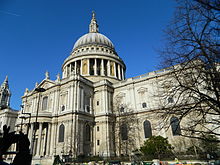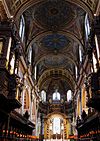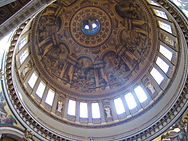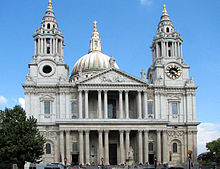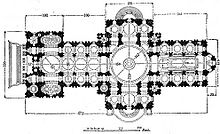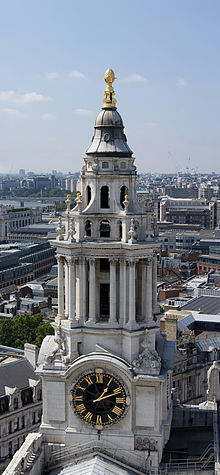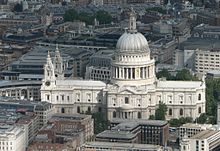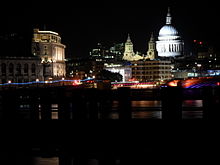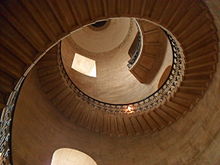
St Paul's Cathedral
About this schools Wikipedia selection
SOS Children produced this website for schools as well as this video website about Africa. Visit the SOS Children website at http://www.soschildren.org/
| St Paul's | |
|---|---|
| Cathedral Church of St Paul the Apostle | |
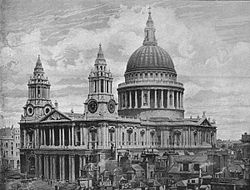 |
|
| 51°30′49″N 0°05′53″W Coordinates: 51°30′49″N 0°05′53″W | |
| Location | City of London |
| Country | United Kingdom |
| Denomination | Church of England |
| Website | www.stpauls.co.uk |
| History | |
| Consecrated | 1708 |
| Architecture | |
| Previous cathedrals | 4 |
| Architect(s) | Sir Christopher Wren |
| Style | English Baroque |
| Years built | 604; 962; circa 1088 to 1314; 1677 |
| Specifications | |
| Length | 518ft (158m) |
| Nave width | 121ft (37m) |
| Width across transepts | 246ft (75m) |
| Height | 365ft (111m) |
| Dome height (outer) | 278ft (85m) |
| Dome height (inner) | 225ft (68m) |
| Dome diameter (outer) | 112ft (34m) |
| Dome diameter (inner) | 102ft (31m) |
| Number of towers | 2 |
| Tower height | 221ft (67m) |
| Administration | |
| Diocese | London (since 604) |
| Province | Canterbury |
| Clergy | |
| Bishop(s) | Richard Chartres |
| Dean | David Ison (from 25 May 2012) |
| Canon(s) | Michael Colclough Pastor Mark Oakley Treasurer Michael Hampel Precentor vacant Chancellor Lucrezia Walker Lay Canon Gavin Ralston Lay Canon Peter McCullough Lay Canon |
| Laity | |
| Director of music | Andrew Carwood |
St Paul's Cathedral, London, is a Church of England cathedral and seat of the Bishop of London. Its dedication to Paul the Apostle dates back to the original church on this site, founded in AD 604. St Paul's sits at the top of Ludgate Hill, the highest point in the City of London, and is the mother church of the Diocese of London. The present church dating from the late 17th century was built to an English Baroque design of Sir Christopher Wren, as part of a major rebuilding program which took place in the city after the Great Fire of London, and was completed within his lifetime.
The cathedral is one of the most famous and most recognisable sights of London, with its dome, framed by the spires of Wren's City churches, dominating the skyline for 300 years. At 365 feet (111 m) high, it was the tallest building in London from 1710 to 1962, and its dome is also among the highest in the world. In terms of area, St Paul's is the second largest church building in the United Kingdom after Liverpool Cathedral.
St Paul's Cathedral occupies a significant place in the national identity of the English population. It is the central subject of much promotional material, as well as postcard images of the dome standing tall, surrounded by the smoke and fire of the Blitz. Important services held at St Paul's include the funerals of Lord Nelson, the Duke of Wellington and Sir Winston Churchill; Jubilee celebrations for Queen Victoria; peace services marking the end of the First and Second World Wars; the wedding of Charles, Prince of Wales, and Lady Diana Spencer, the launch of the Festival of Britain and the thanksgiving services for the Golden Jubilee, the 80th Birthday and the Diamond Jubilee of Elizabeth II. St Paul's Cathedral is a busy working church, with hourly prayer and daily services.
Previous cathedrals
Pre-Norman
There had been a late-Roman episcopal see in London. According to the tradition recorded by Bede, the first Saxon cathedral was built by Mellitus in AD 604 in Lundenwic. The unproven conjecture that it occupied the site of the present cathedral is supported by the fact that it was these missionaries' habit, as in mainland Europe, to build cathedrals within Roman cities. However, the Roman city of London, then called Lundenburh, was unoccupied at that time, unlike conditions in the areas of continental Europe where there was continuity of urban occupation and ecclesiastic succession. Geoffrey of Monmouth claimed that the cathedral had been built on the site of a temple dedicated to the goddess Diana, in alignment with the Apollo temple that he imagined once stood at Westminster, although Christopher Wren found no evidence of this. Geoffrey was disbelieved by contemporaries, and there is no evidence of any occupation at the Westminster site in the Roman period. If any church building existed, perhaps a reutilised existing structure, then it would have only been a modest chapel at first and may well have been destroyed after Mellitus was expelled from the city by Sæberht's pagan successors.
Wherever its predecessor was sited, the successor building within the reoccupied City (built ca 886) was destroyed in a "most fatal fire" in 962, as mentioned in the Anglo-Saxon Chronicle. Presumably it was made of timber.
The third cathedral was begun in 962, perhaps in stone. In it was buried Ethelred the Unready. It burnt, with the whole city, in a fire in 1087, noted in the Anglo-Saxon Chronicle.
Old St Paul's
The fourth St Paul's, known when architectural history arose in the 19th century as Old St Paul's, was begun by the Normans after the 1087 fire. Work took over 200 years and a great deal was lost in a fire in 1136. The roof was once more built of wood, which was ultimately to doom the building. The church was consecrated in 1240, but a change of heart led to the commencement of an enlargement programme in 1256. When this 'New Work' was completed in 1314 — the cathedral had been consecrated in 1300 — it was the third-longest church in Europe and had one of Europe's tallest spires, at some 489 feet (149 m). Excavations by Francis Penrose in 1878 showed that it was 585 feet (178 m) long and 100 feet (30 m) wide (290 feet or 87 m across the transepts and crossing).
By the 16th century the building was decaying. Under Henry VIII and Edward VI, the Dissolution of the Monasteries and Chantries Acts led to the destruction of interior ornamentation and the cloisters, charnels, crypts, chapels, shrines, chantries and other buildings in St Paul's Churchyard. Many of these former religious sites in the churchyard, having been seized by the Crown, were sold as shops and rental properties, especially to printers and booksellers, who were often Puritans. Buildings that were razed often supplied ready-dressed building material for construction projects, such as the Lord Protector's city palace, Somerset House.
Crowds were drawn to the northeast corner of the churchyard, St Paul's Cross, where open-air preaching took place. In 1561 the spire was destroyed by lightning and it was not replaced; this event was taken by both Protestants and Roman Catholics as a sign of God's displeasure at the other faction's actions.
England's first classical architect, Inigo Jones, added the cathedral's west front in the 1630s, but there was much defacing mistreatment of the building by Parliamentarian forces during the Civil War, when the old documents and charters were dispersed and destroyed (Kelly 2004). "Old St Paul's" was gutted in the Great Fire of London of 1666. While it might have been salvageable, albeit with almost complete reconstruction, a decision was taken to build a new cathedral in a modern style instead. Indeed this had been contemplated even before the fire.
Wren's cathedral
Design and construction
The task of designing a replacement structure was officially assigned to Sir Christopher Wren on 30 July 1669. He had previously been put in charge of designing over fifty other City churches. During the extensive period of design and rationalisation Wren employed from 1684 Nicholas Hawksmoor as his principal assistant. Concurrent with designing St Paul's, Wren was enagaged in the production of his five Tracts on Architecture.
Wren had begun advising on the repair of the cathedral before the Great Fire of 1666, in fact as early as 1661. This included drawings for the addition of a dome to the existing building to replace the dilapidated spire, and a restoration of the interiors that would complement the 1630 Inigo Jones-designed facade. After the fire, the ruins of the building were still thought to be workable, but ultimately the entire structure was demolished in the early 1670s to start afresh.
St Paul's went through five general stages of design. The first survives only in the form of a part of a model and a single drawing. The scheme (usually called the First Model Design) appears to have consisted of a round domed entrance vestibule (possibly based on the Pantheon in Rome) and a rectangular basilica behind containing the choir. It was rejected because it was not thought "stately enough" Wren’s second design was a Greek cross, which was considered to be too radical by his critics.
Wren's third proposal for the new St Paul's used many of the same design concepts as his Greek cross design, though it had an extended nave. This design was embodied in his creation in 1673 of the " Great Model". The model, made of oak and plaster, cost over £500 (approximately £32,000 today) and is over 13 feet (4 m) tall and 21 feet (6 m) long. His critics, members of a committee commissioned to rebuild the church and members of the clergy, decried the design as being too dissimilar from churches that already existed in England at the time to suggest any continuity within the Church of England. Clergymen also preferred a Latin cross plan for services. Another problem was that the entire design would have to be completed all at once because of the eight central piers that supported the dome, instead of being completed in stages and opened for use before construction finished, as was customary. Wren considered the Great Model his favourite design, and thought it a reflection of Renaissance beauty. After the Great Model, Wren resolved to make no more models or publicly expose his drawings, which he found to do nothing but "lose time, and subject his business many times, to incompetent judges".
Wren's fourth design, the Warrant design, sought to reconcile the Gothic, the predominant form of English churches, to a "better manner of architecture." Wren attempted to integrate the same concepts of Renaissance harmony into a more Gothic tradition - however Vaughan Hart identifies exotic inspiration behind the remarkable pagoda-like spire. This design was rotated slightly on its site so that it aligned not with true east, but with sunrise on Easter of the year construction began. This small change in configuration made by Wren was informed by his knowledge of astronomy. His design of the portico was influenced by Inigo Jones’s addition to Old St Paul's.
The final design as built differs substantially from the official Warrant design. Wren received permission from the king to make "ornamental changes" to the submitted design, and Wren took great advantage of this. Many of these changes were made over the course of the thirty years as the church was constructed, and the most significant was to the dome: "He raised another structure over the first cupola, a cone of brick, so as to support a stone lantern of an elegant figure... And he covered and hid out of sight the brick cone with another cupola of timber and lead; and between this and the cone are easy stairs that ascend to the lantern" (Christopher Wren, son of Sir Christopher Wren). The final design was strongly rooted in St Peter's Basilica in Rome. The saucer domes that were eventually added to the design were inspired by François Mansart's Val-de-Grâce, which Wren had seen during a trip to Paris in 1665. The date of the laying of the first stone of the cathedral is disputed. One contemporary account says it was on 21 June 1675, another on 25 June and a third on 28 June. There is, however, general agreement that it was laid in June 1675. Edward Strong later claimed it was laid by his elder brother, Thomas Strong, one of the two master stonemasons appointed by Wren at the beginning of the work.
On 2 December 1697, thirty-two years and three months after a spark from Farryner's bakery had caused the Great Fire of London, St Paul's Cathedral came into use. The widower King William III had been scheduled to appear but, uncomfortable in crowds and public displays, had bowed out at the last minute. The crowd of both the great and the small was so big, and their attitude towards William so indifferent, that he was scarcely missed. The Right Reverend Henry Compton, Bishop of London, preached the sermon. It was based on the text of Psalm 122, "I was glad when they said unto me: Let us go into the house of the Lord." The first regular service was held on the following Sunday.
The "topping out" of the cathedral (when the final stone was placed on the lantern) took place in October 1708 and the cathedral was declared officially complete by Parliament on 25 December 1711 (Christmas Day). In fact construction was to continue for several years after that, with the statues on the roof only being added in the 1720s. In 1716 the total costs amounted to £1,095,556 (£147 million as of 2013).
The consensus was as it is with all such works: some loved it ("Without, within, below, above the eye/ Is filled with unrestrained delight."); some hated it ("...There was an air of Popery about the gilded capitals, the heavy arches...They were unfamiliar, un-English.."); while most, once their curiosity was satisfied, didn't think about it one way or another.
- Sir Christopher Wren
- Said, "I am going to dine with some men.
- If anyone calls,
- Say I'm designing Saint Paul's."
-
- A clerihew by Edmund Clerihew Bentley
Structural engineering
Wren's challenge was to construct a large classical cathedral on the relatively weak clay soil of London. Settlement of the foundations caused major problems, forcing Wren to change his dome designs as the work progressed.
The Warrant Design showed external buttresses on the ground floor level. These were not a classical feature and were one of the first elements Wren changed. Instead he made the walls of the cathedral particularly thick to avoid the need for external buttresses altogether. The windows are set into deep recesses in the walls. The upper parts of the cathedral walls are reinforced with small flying buttresses, which were added at a relatively late design change to give extra strength. These are concealed behind a large screen wall, which was added to keep the building's classical style intact.
The large crossing dome is composed of three layers: the first triple dome ever to be constructed. The inner and outer layers are catenary curves, but the structural integrity to support the heavy stone structure atop the dome is provided by an intermediary layer which is much steeper and more conical in shape. The dome is restrained round its base by a wrought iron chain to prevent it spreading and cracking. Further iron chains are in some stone bands at intervals in the brick cone and around the cornice of the peristyle.
Artists and craftsmen
The construction and decoration of the Cathedral involved many of the foremost artists and craftsmen in England; these were:
- Sir James Thornhill – painted the eight monochrome paintings of the life of St Paul that adorn the interior of the dome. Engravings of the paintings were published in 1720.
- Grinling Gibbons – responsible for the woodwork, most notably the choir stalls, and sculpted the pediment of the north transept.
- Jean Tijou – most of the wrought ironwork, including the gates flanking the high altar.
- Bernard Smith – designed and built the organ.
- Caius Gabriel Cibber – sculpted the pediment of the south transept.
- Francis Bird – sculpted the great west pediment showing the conversion of St Paul, plus the seven large sculptures on the west front.
Description
The cathedral is built of Portland stone in a late Renaissance style that represents Wren's vision of a rationalised English Baroque. Its impressive dome was inspired by St Peter's Basilica in Rome and Mansart's Church of the Val-de-Grâce which Wren had visited. It rises 365 feet (108 m) to the cross at its summit, dominating both the historic and modern City of London through the Baroque device of axial perspectives or 'viewing corridors' across the cityscape. Wren achieved a pleasing balance between interior and exterior by constructing three domes nested one inside the other: the tall outer dome is non-structural and raised above the mass of the cathedral to suit distanced views; the lower inner dome provides a harmoniously balanced interior; between the two a structural cone supports the apex lantern and the outer dome. Wren was said to have been hauled up to the rafters in a basket during the building of its later stages to inspect progress.
The nave has three small chapels in the two adjoining aisles – The Chapel of All Souls and The Chapel of St Dunstan in the north aisle and the Chapel of St Michael and St George in the south aisle. The main space of the cathedral is centred under the inner dome, which rises 108.4 metres from the cathedral floor and holds three circular galleries – the internal Whispering Gallery, the external Stone Gallery, and the external Golden Gallery.
The Whispering Gallery runs around the inside of the dome 99 feet (30.2 m) above the cathedral floor. It is reached by 259 steps from ground level. It gets its name because of the acoustic effects peculiar to domes; a whisper against its wall at any point is audible to a listener with an ear held to the wall at any other point around the gallery. A low murmur is equally audible.
The base of the inner dome is 173 feet (53.4 m) above the floor. Its top is about 65 m above the floor, making this the greatest height of the enclosed space. The cathedral is some 574 feet (175 m) in length (including the portico of the Great West Door), of which 223 feet (68 m) is the nave and 167 feet (51 m) is the choir. The width of the nave is 121 feet (37 m) and across the transepts is 246 feet (75 m). The cathedral is thus slightly shorter but somewhat wider than Old St Paul's.
The quire extends to the east of the dome and holds the stalls for the clergy and the choir and the organ. To the north and south of the dome are the transepts, here called the North Choir and the South Choir.
Details of the towers at the west end (illustration, left) and their dark voids are boldly scaled, in order to read well from the street below and from a distance, for the towers have always stood out in the urban skyline. They are composed of two complementary elements, a central cylinder rising through the tiers in a series of stacked drums, and paired Corinthian columns at the corners, with buttresses above them, which serve to unify the drum shape with the square block plinth containing the clock. The main entablature breaks forward over the paired columns to express both elements, tying them together in a single horizontal band. The cap, like a bell-shaped miniature dome, supports a gilded finial, a pineapple supported on four scrolling angled brackets, the topmost expression of the consistent theme.
The clock mechanism was built in 1893 by Smith of Derby incorporating a design of escapement by Edmund Denison Beckett similar to that used by Edward Dent on the ' Big Ben' mechanism in 1895. The clock mechanism is 5.8 metres long and is the most recent of the clocks introduced to St Paul's Cathedral over the centuries. Since 1969 the clock has been electrically wound with equipment designed and installed by Smith of Derby, relieving the clock custodian from the work of cranking up the heavy drive weights.
The north-west tower contains 13 bells hung for change ringing while the south-west contains four, including Great Paul, at 16½ tons- the largest bell in the British Isles, cast in 1881 by Taylor's bell foundry of Loughborough, Leicestershire, and Great Tom (the hour bell), recast twice, the last time by Richard Phelps, after being moved from St Stephen's Chapel at the Palace of Westminster. The bell is only rung on occasions of a death in the royal family, the Bishop of London, or the Lord Mayor of London, although an exception was made at the death of US President James Garfield. In 1717, Richard Phelps cast two more bells that were added as " quarter jacks". Still in use today, the first weighs 13 long hundredweights (1,500 lb; 660 kg), is 41 inches (1,000 mm) in diameter and is tuned to A flat; the second weighs 35 long hundredweights (3,900 lb; 1,800 kg) and is 58 inches (1,500 mm) in diameter and is tuned to E flat.
| Bell | Weight | Nominal | Note | Diameter | Cast | Founder |
|---|---|---|---|---|---|---|
| 1 | 8-1-4 | 1461.0 | F | 30.88" | 1878 | John Taylor & Co |
| 2 | 9-0-20 | 1270.0 | E♭ | 32.50" | 1878 | John Taylor & Co |
| 3 | 9-3-12 | 1199.0 | D | 34.00" | 1878 | John Taylor & Co |
| 4 | 11-2-22 | 1063.0 | C | 36.38" | 1878 | John Taylor & Co |
| 5 | 13-1-0 | 954.0 | B♭ | 38.63" | 1878 | John Taylor & Co |
| 6 | 13-2-14 | 884.0 | A | 39.63" | 1878 | John Taylor & Co |
| 7 | 16-1-18 | 784.0 | G | 43.75" | 1878 | John Taylor & Co |
| 8 | 21-3-18 | 705.0 | F | 47.63" | 1878 | John Taylor & Co |
| 9 | 27-1-22 | 636.0 | E♭ | 52.50" | 1878 | John Taylor & Co |
| 10 | 29-3-21 | 592.0 | D | 55.25" | 1878 | John Taylor & Co |
| 11 | 43-2-0 | 525.0 | C | 61.25" | 1878 | John Taylor & Co |
| 12 | 61-2-12 | 468.0 | B♭ | 69.00" | 1878 | John Taylor & Co |
| Clock | 12-2-9 | A♭ | 1707 | Richard Phelps | ||
| Clock | 24-2-26 | E♭ | 1707 | Richard Phelps | ||
| Clock | 102-1-22 | A♭ | 82.88" | 1716 | Richard Phelps | |
| Bourdon | 334-2-19 | E♭ | 114.75" | 1881 | John Taylor & Co | |
| Communion | 18-2-26 | E♭ | 49.50" | 1700 | Philip Wightman |
War damage
The cathedral survived despite being targeted during the Blitz — it was struck by bombs on 10 October 1940 and 17 April 1941. On 12 September 1940 a time-delayed bomb that had struck the cathedral was successfully defused and removed by a bomb disposal detachment of Royal Engineers under the command of Temporary Lieutenant Robert Davies. Had this bomb detonated, it would have totally destroyed the cathedral, as it left a 100-foot (30 m) crater when later remotely detonated in a secure location. As a result of this action, Davies and Sapper George Cameron Wylie were both awarded the George Cross. Davies's George Cross and other medals are on display at the Imperial War Museum, London.
On 29 December 1940, the cathedral had another close call when an incendiary bomb became lodged in the lead shell of the dome but fell outwards onto the Stone Gallery and was put out before it could ignite the dome timbers. Many fire watchers served shifts on the dome: these included Major Cyril Raikes.
One of the best known images of London during the war was a photograph of St Paul's taken the same day by photographer Herbert Mason, from the roof of the Daily Mail in Tudor Street showing the cathedral shrouded in smoke. Lisa Jardine of Queen Mary, University of London has written:
Wreathed in billowing smoke, amidst the chaos and destruction of war, the pale dome stands proud and glorious – indomitable. At the height of that air-raid, Sir Winston Churchill telephoned the Guildhall to insist that all fire-fighting resources be directed at St Paul's. The cathedral must be saved, he said, damage to the fabric would sap the morale of the country.
Memorials
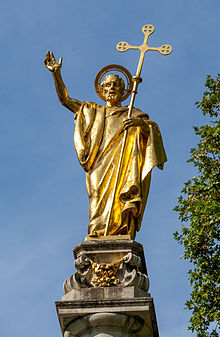
The cathedral has a very substantial crypt, holding over 200 memorials, and serves as both the Order of the British Empire Chapel and the Treasury. The cathedral has very few treasures: many have been lost, and in 1810 a major robbery took almost all of the remaining precious artefacts. Christopher Wren was the first person to be interred, in 1723: on the wall above his tomb in the crypt is written, "Lector, si monumentum requiris, circumspice" (Reader, if you seek his monument, look around you).
St Paul's is home to other plaques, carvings, statues, memorials and tombs of famous British figures including:
- Sir John Eardley Inglis
- General Sir Isaac Brock
- Charles Robert Cockerell
- Sir Edwin Lutyens
- John Donne, whose funeral effigy (portraying him in a shroud) but not his tomb survives from Old St Paul's.
- Lord Kitchener
- The Duke of Wellington
- Lord Nelson
- Henry Moore
- Cuthbert Collingwood, 1st Baron Collingwood
- Sir William Alexander Smith
- Sir Winston Churchill
- T. E. Lawrence, whose bust faces Nelson's sarcophagus
- Sir Alexander Fleming
- Garnet Wolseley, 1st Viscount Wolseley
- John Colet
- Sir Philip Vian
- John Jellicoe, 1st Earl Jellicoe
- David Beatty, 1st Earl Beatty
- Sir Arthur Sullivan
- Sir Lawrence Alma-Tadema
- Sir Hubert Parry
- Florence Nightingale
- J. M. W. Turner
- Sir Joshua Reynolds
- Dr. Samuel Johnson
- Ivor Novello
- Charles Cornwallis
- Frederick George Jackson
- Mandell Creighton and Louise Creighton
- Roy Thomson, 1st Baron Thomson of Fleet
Most of the memorials commemorate the British military, including several lists of servicemen who died in action, the most recent being the Gulf War. There are special monuments to Lord Nelson in the south transept and to the Duke of Wellington in the north aisle; both are buried here. Also remembered are poets, painters, clergy and residents of the local parish. There are lists of the Bishops and cathedral Deans for the last thousand years.
The cathedral has been the site of many famous funerals, including those of Horatio Nelson, the Duke of Wellington, Sir Winston Churchill and George Mallory.
Former prime minister Margaret Thatcher is set to have a state funeral at the cathedral upon her death.
American Memorial Chapel
The apse of the cathedral is home to the American Memorial Chapel. It honours American servicemen and women who died in World War II, and was dedicated in 1958. It was paid for entirely by donations from British people, and was designed, as a modern exercise in the Wren style, by Godfrey Allen and Stephen Dykes Bower. The Roll of Honour contains the names of more than 28,000 Americans who gave their lives while on their way to, or stationed in, the United Kingdom during the Second World War. It is in front of the chapel's altar. The three chapel windows date from 1960; they feature themes of service and sacrifice, while the insignia around the edges represent the American states and the US armed forces. The limewood panelling incorporates a rocket – a tribute to America's achievements in space.
St Paul's Cathedral Arts Project
The St Paul’s Cathedral Arts Project is an ongoing programme which seeks to explore the encounter between art and faith. Projects have included installations by Antony Gormley, Rebecca Horn, Yoko Ono and Martin Firrell.
Internationally acclaimed artist Bill Viola has been commissioned to create two altarpieces for permanent display in St Paul's Cathedral. The project commenced production in mid 2009 with completion in early 2012. Following the extensive programme of cleaning and repair of the interior of St Paul's, completed in 2005, Bill Viola has been commissioned to create two altarpieces on the themes of Mary and Martyrs. These two multi-screen video installations will be permanently located at the end of the Quire aisles, flanking the High Altar of the Cathedral and the American Memorial Chapel where US Service men and women who gave their lives in the Second World War are commemorated. Each work will employ an arrangement of multiple plasma screen panels configured in a manner similar to historic altarpieces. The screens will be mounted on hinged panels, allowing them to be closed.
In Summer 2010, St Paul's chose two new works by the British artist Mark Alexander to be hung either side of the nave. Both entitled Red Mannheim, Alexander's large red silkscreens are inspired by the Mannheim Cathedral altarpiece (1739–41), which was damaged by bombing in the Second World War. The original sculpture depicts Christ on the cross, surrounded by a familiar retinue of mourners. Rendered in splendid giltwood, with Christ's wracked body sculpted in relief, and the flourishes of flora and incandescent rays from heaven, this masterpiece of the German Rococo is an object of ravishing beauty and intense piety.
In March 2010, Flare II, a sculpture by Antony Gormley, was installed in the dramatic setting of the Geometric Staircase.
In 2007, Dean and Chapter commissioned public artist Martin Firrell to create a major public artwork to mark the 300th anniversary of the topping-out of Wren's building. The Question Mark Inside consisted of digital text projections to the cathedral dome, West Front and inside onto the Whispering Gallery. The text was based on blog contributions by the general public as well as interviews conducted by the artist and the artist's own views. The project presented a stream of possible answers to the question: 'what makes life meaningful and purposeful, and what does St Paul's mean in that contemporary context?' The Question Mark Inside opened on 8 November 2008 and ran for eight nights.
A 15 year restoration project – one of the largest ever undertaken in the UK – was completed on 15 June 2011.
Tourism
Interpretation Project
The Interpretation Project is a long term project concerned with bringing St Paul’s to life for all its visitors. In 2010, the Dean and Chapter of St Paul's opened St Paul's Oculus, a 270° film experience that brings 1400 years of history to life. Located in the former Treasury in the crypt, the film takes visitors on a journey through the history and daily life of St Paul's Cathedral. Oculus was funded by American Express Company in partnership with the World Monuments Fund, J. P . Morgan, the Garfield Weston Trust for St Paul’s Cathedral, the City of London Endowment Trust and AIG.
In 2010, new touchscreen multimedia guides were also launched. These guides are included in the price of admission. Visitors can discover the cathedral’s history, architecture and daily life of a busy working church with these new multimedia guides. They are available in 12 different languages: English, French, German, Italian, Spanish, Portuguese, Polish, Russian, Mandarin, Japanese, Korean and British Sign Language (BSL). The guides have fly-through videos of the dome galleries and zoomable close-ups of the ceiling mosaics, painting and photography. Interviews and commentary from experts include the Dean of St Paul’s, conservation team and the Director of Music. Archive film footage includes major services and events from the cathedral's history.
Charges for sightseers
St Paul’s imposes a £14.50 charge for admission to sightseers (£12.50 when purchased online), without the option of a donation. Those attending services do so at no cost. People seeking a place to be quiet and pray are admitted to the St Dunstan's Chapel free of charge. Admission on Sundays for all services is free and there is no sightseeing. The cathedral explains that St Paul's receives little regular or significant funding from the Crown, Church or the State and claims to rely on the income generated by tourism to allow the building to continue to function as a centre for Christian worship, as well as to cover general maintenance and repair work.
The finances of the cathedral came under public scrutiny during the anti-capitalism Occupy London encampment in front of the cathedral which began in October 2011. Canon Chancellor Giles Fraser resigned, warning that to evict the anti-capitalist activists would constitute “violence in the name of the Church". It was claimed that the cathedral was losing revenue of £20,000 per day. The encampment was evicted at the end of February 2012, after legal action by the City Corporation.
Organ and organists
Organ
The organ was commissioned in 1694: the current instrument is the third-largest in Great Britain in terms of number of pipes (7,266 pipes), with 5 manuals, 189 ranks of pipes and 108 stops, enclosed in an impressive case by Grinling Gibbons.
Details of the organ from the National Pipe Organ Register
Organists and directors of music
|
|
|
Sub-organists and assistant organists
- George Cooper (father) 1???-1838
- George Cooper (son) 1838–1876 (also Organist HM Chapel Royal)
- George Clement Martin MVO 1876–1888 (subsequently Organist)
- William Hodge 1888–1895
- Charles Macpherson 1895–1916 (subsequently Organist)
- Stanley Marchant CVO 1916–1927 (subsequently Organist)
- Douglas Edward Hopkins 1927–1946 (subsequently Organist Peterborough Cathedral; later Organist Canterbury Cathedral)
- Harry Gabb CVO 1946–1974 (also Organist, Choirmaster & Composer HM Chapel Royal)
- Barry Rose OBE 1974–1984 (Master of the Choir 1977–1984; later Master of Music St Albans Abbey)
- John Scott LVO 1985–1990 (subsequently Organist and Director of Music; now Director of Music St Thomas, Fifth Avenue)
- Andrew Lucas 1990–1998 (now Master of Music, St Albans Abbey)
- Huw Williams 1998–2008 (now Sub Organist, HM Chapel Royal)
In 2007 the posts of Organist and Director of Music were separated, the Sub-Organist post being re-titled Organist & Assistant Director of Music in September 2008.
- Simon Johnson 2008 (September) – present
Assistant sub-organists and sub-organists
- Gerald Wheeler 1953–1956
- Derek Holman CM 1956–1958
- Richard Popplewell LVO 1958–1966 (subsequently Organist, Choirmaster & Composer HM Chapel Royal)
- Timothy Farrell 1966–1967 (subsequently Organist, Choirmaster & Composer HM Chapel Royal)
- Christopher Herrick 1967–1978 (subsequently Sub-Organist Westminster Abbey)
- John Scott LVO 1978–1985 (simultaneously held post of Assistant Organist Southwark Cathedral; subsequently Sub-Organist)
- Andrew Lucas 1985–1990 (subsequently Sub-Organist)
- Martin Baker 1990–1991 (later Sub-Organist & Acting Organist Westminster Abbey; now Master of Music Westminster Cathedral)
- Richard Moorhouse 1992–2000 (now Organist & Master of the Choristers Llandaff Cathedral)
- Mark Williams 2000–2006 (now Director of Music Jesus College, Cambridge)
- Tom Winpenny 2006–2008 (now Assistant Master of Music St Albans Abbey)
In 2007 the posts of Organist and Director of Music were separated, the Assistant Sub-Organist post being re-titled Sub-Organist in April 2008.
- Timothy Wakerell 2008–present
Almoners and masters of the choristers
|
The title of Almoner then passed to one of the Minor Canons, while the post of Master of the Choristers was held by a succession of Vicars Choral, including –
until –
The training of the choristers was then entrusted to the Organist & his deputies until –
The post was re-united with that of Organist under John Scott in 1990 |
Organ scholars
- John Dexter 1975 (Organist and Master of the Choristers at St Patrick's Cathedral, Dublin 1977–2001)
- Ian Sadler 1978
- Gareth Green
- Martin Cooke
- Mark Blatchly (now Organist Charterhouse School)
- Andrew Lucas 1980–1984 (subsequently Assistant Sub-Organist)
- Simon Lole 1979–1982 (later Organist & Director of Music Sheffield Cathedral & then Salisbury Cathedral)
- Andrew Shenton (now Associate Professor of Music at Boston University)
- Roger Sayer (now Organist Rochester Cathedral)
- Lee Ward 1989
- David Whitehead 1990
- Fraser Simpson 1992
- Huw Williams 1993 (later Sub-Organist)
- Stuart Nicholson (now Organist & Master of the Choristers St Patrick's Cathedral, Dublin)
- Lionel Steuart Fothringham (now Director of Music Highgate School)
- Simon Johnson 1997 (subsequently Assistant Master of the Music St Albans Abbey; now Organist & Assistant Director of Music)
- Benjamin Nicholas 1998 (now Director of Music Merton College, Oxford)
- Nicholas Chalmers 2000 (now Assistant Chorus Master English National Opera)
- Thomas Corns 2001 (now Organist St Mary's Warwick)
- Duncan Ferguson 2003 (now Organist & Master of the Music St Mary's, Edinburgh)
- James Kennerly 2005
- James McVinnie 2006
- Tim Harper 2008 (now Assistant Director of Music Birmingham Cathedral)
- Donald Hunt 2010 (now Assistant Organist St Mary's, Edinburgh)
- Simon Hogan 2011 (now Assistant Director of Music Southwell Minster)
- Richard Moore (from Sep 2012)
Some notable choristers and vicars choral
- 16th century
- William Mundy (Vicar Choral), composer.
- Peter Philips (chorister), composer.
- 17th century
- Adrian Batten (Vicar Choral), composer.
- 18th century
- Jonathan Battishill (chorister), composer.
- William Boyce (chorister), composer.
- Maurice Greene (chorister), composer and Organist of St Paul's Cathedral.
- 19th century
- William Cummings (chorister), composer and organist.
- Frederick Ranalow (chorister), baritone and actor
- John Stainer (chorister), Organist of St Paul's Cathedral and Professor of Music at Oxford University.
- 20th century
- Simon Russell Beale (chorister), actor.
- Alastair Cook (chorister), cricketer.
- Alfred Deller (Vicar Choral), counter-tenor.
- Jimmy Edwards (chorister), actor.
- Gerald English (Vicar Choral), tenor.
- Charles Groves (chorister), conductor.
- Paul Hillier (Vicar Choral), conductor.
- Robin Holloway (chorister), composer.
- Neil Howlett (chorister), opera singer and teacher.
- James Lancelot (chorister), Organist of Durham Cathedral.
- Walter de la Mare (chorister), poet and novelist.
- Stephen Oliver (chorister), composer.
- Julian Ovenden (chorister), actor and singer.
- John Shirley-Quirk (Vicar Choral), bass-baritone.
- Robert Tear (Vicar Choral), tenor and conductor.
- Anthony Way (chorister), treble.
Filming
Films and TV programmes featuring St Paul's Cathedral include:
- Climbing Great Buildings (2010)
- Industrial Revelations: Best of British Engineering – Buildings, with Rory McGrath series 5, episode 1, 2008, focuses on St Paul's Cathedral.
- St Paul's Cathedral has appeared numerous times in Doctor Who, most notably the 1968 episode, The Invasion. In one scene, a group of Cybermen are shown climbing out of some manholes in Central London, before descending a stairway in front of the Cathedral.
- Saint Paul's is seen briefly in the Goodies episode, Kitten Kong. During his rampage through London, Twinkle does damage to various London landmarks, including Saint Paul's Cathedral, which has its dome knocked off when he bursts out of the centre of the famous church.
- Harry Potter and the Prisoner of Azkaban shows the Geometric Staircase in the South West Bell Tower.
- The Madness of King George shows the Geometric Staircase in the South West Bell Tower.
- Mary Poppins shows the front and outside of the Cathedral, though it shows the space from the missing clock, when that was caused by bombing during World War II, 30 years after the film was set.
- Sherlock Holmes (2009) shows the North side of the West Steps, and the Geometric Staircase in the South West Bell Tower.
- Lawrence of Arabia (1962) shows the exterior of the building and T E Lawrence's bust.





